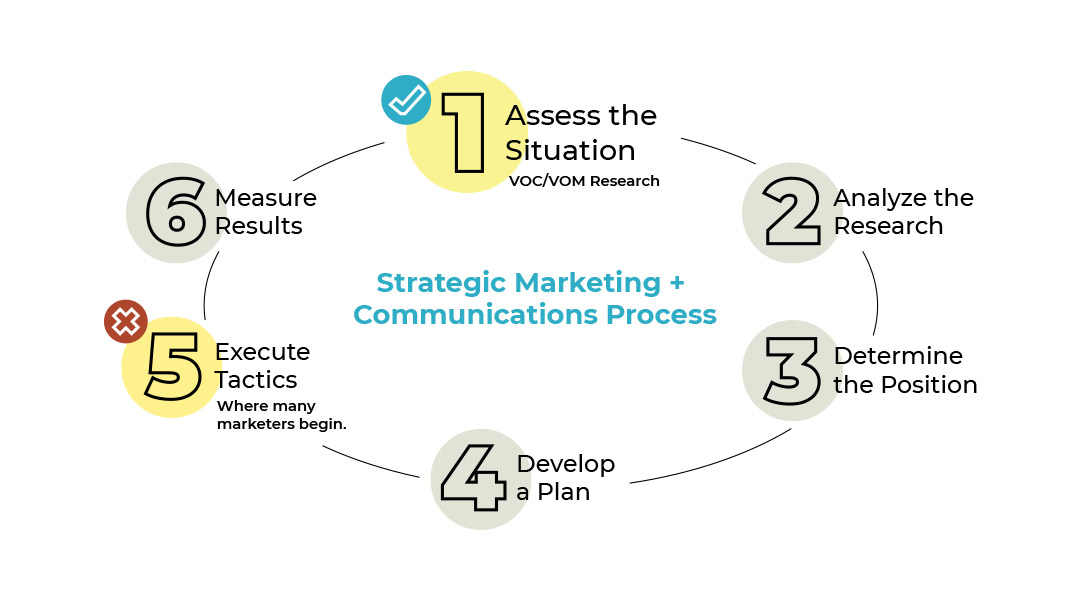3 reasons you can’t afford to leave research out of this year’s (B2B) strategy planning session
Fall: the time of year for sweaters, pumpkin lattes, and of course, communications planning sessions. We marketers are busy fighting for budget dollars, aligning business objectives and trying to sort through the unending list of product and company “priorities” that each need our attention and dollars.

I’ve been through a few of these seasons (not saying how many) and one element that rarely makes it onto the shortlist of objectives is research. I’m not talking about smaller-scale research, such as website analytics, social listening, database analysis or product launch specific research. I am talking about larger, strategic research that dictates who you are in the market, precisely where you fit, and where you are going. Whether it is voice of customer (VOC) or voice of market (VOM) research, what should be the foundation of our marketing strategy is often conspicuously absent in our annual planning sessions.
By not digging deeper into where our companies and products fit in the market and in our customers’ minds, we are failing to consider critical points of view that could be informing and driving the very marketing strategies we are “planning.” That’s a big deal.

It’s easy to understand why strategy research is frequently absent from our annual planning. Research of this size can be an arduous task. It is often expensive, time-consuming and involves multiple levels of internal and external stakeholders. It may also challenge the status quo. Nevertheless, whether your objective is sales, thought leadership or branding, understanding how and where you fit in the market and/or in your customer’s mind is essential to determining the roadmap to keep your business competitive and moving forward.
Still not ready to fight the good fight for research budget dollars? Here are three reasons why research should absolutely be included in your 2021 plans. (Hint – they all make your life easier!)
1. Sharpen (or define) Your Message
It seems simple enough – how can you talk about your product or service if you don’t know what or how to talk about it? Without your customers’ perspective, how you talk about your wares is totally irrelevant. You can think you know what the market wants and needs from you, but until you ask, you really don’t know.
This is where VOC or VOM research can help. The research is conducted through in-depth, third-party interviews where respondents feel free and comfortable speaking their mind. And speak they often do! Skilled researchers know how to create a good rapport and can pull a wealth of information from your customers (and former customers) beyond the interview questions. While qualitative in nature, in aggregate these types of honest responses give you more than a data point; they give you valuable insight into the unique position your product, service or company fits in the market.

This gives you the information you need, so when you have excess capacity to sell, you know exactly how to position that product to most effectively sell it. You aren’t allowing internal priorities to shape your message; you are allowing the market to guide you to the messaging sweet spot. Sometimes this affirms what you knew, but most often the data can lead you to an unexplored corner of the market or message point. In other words, this nuanced message can take you from “being the leader in abc” to the “partner in xyz.” This knowledge makes every campaign or marcomm asset you create exponentially easier because you have a firm handle – grounded in data – on what you need to say to your customers to move the needle.
2. Maximize Your Marketing Budget and ROI
How often have you been asked for the ROI on your communications programs? As we all know, some metrics are easier to obtain than others. Explaining impressions and brand value to a person in a leadership position, whose background is something other than marketing, can be challenging. Basing your campaign goals and tactics on a bedrock of VOC or VOM research, allows you to speak a data-based language your management can appreciate and makes executing your plan and justifying the dollars spent much easier.
With your data-driven, targeted message platform identified, you now know exactly what and how to speak to your customer or market. It’s no longer necessary to question which methods will work and what type of message will resonate; you can confidently and effectively allocate your marketing budget in ways that align with and support your data. And, you have a benchmark – based on fact, not conjecture – to measure your campaign results against. In today’s multi-channel world, the right mode is as important as the message.
For example, you may have doubled down in recent years on relationship building at trade shows, because the sales team deemed this a priority (based on opinion, personal perspective, etc.). But the research revealed your customers see you as a trusted partner in R&D and have come to rely on your pilot plant facilities and cutting edge research. Suddenly your communications focus has shifted from an emphasis on trade show participation to investments in webinars, speaking events and white papers. Boom – you just maximized your marketing spend, and you have the numbers, data and VOC/VOM insights to back it up.
- Read more on maximizing your ROI from researcher Jake Pryszlak: https://www.forbes.com/sites/jakepryszlak/2019/02/22/calculating-return-on-investment-from-your-research-insight/#609473f87e19
3. Internal Alignment
This is where VOC or VOM research can make your life incredibly easy. I can speak to the importance of internal communications and the role this plays in your external communications in another blog, but on a management level, having message alignment and sincere buy-in is best achieved when emotions, history, P&L priorities and perceptions are yielded to data. When all the cogs in the wheel are working toward one, well-defined goal, your company benefits, moving forward together in harmony. Contentiousness and stakeholder battles are easily snuffed out by the data. You simply can’t argue with the numbers and getting the resources and support you need to execute your marketing strategy just became easy-peasy.
Research is not a glamorous topic. It is expensive, takes patient planning and a good outside partner. Time must be allotted for the research program’s development, deployment and analysis. And, enough dollars must be budgeted to gather the depth and breadth of information necessary to move the needle and properly inform your marcomm efforts and goal setting.
The good news is that large scale VOC and VOM research is not necessarily an every year line item in your planning. Depending on the industry, competitive landscape and business goals, large, directional research is a once every five-year (or so) project. The results of said research, however, should be examined and reexamined every planning session to ensure the strategy is still aligned with the action items uncovered.
So, is a budget for research really worth fighting for in this year’s comms planning sessions? In a word, absolutely! The investment your company makes is returned in more effective messaging, targeted marketing spend and internal synergy – all of which make your job a whole lot easier. Now that’s a win-win-win.
Don’t know where to start? We can help! Let’s talk about making your marketing communications data-driven – and making your life (a little) easier. Contact us here.
